Difference between revisions of "C-mount"
m (link added) |
|||
| (38 intermediate revisions by 4 users not shown) | |||
| Line 1: | Line 1: | ||
| − | The '''C-mount''' consists of a one-inch diameter cylinder threaded to a pitch of 1/32-in, or 32 threads per inch. | + | {{Flickr_image |
| + | |image_source= https://www.flickr.com/photos/7392884@N04/33487074816/in/pool-camerawiki | ||
| + | |image= http://farm4.staticflickr.com/3939/33487074816_8b159fc82c_n_d.jpg | ||
| + | |image_align= right | ||
| + | |image_text= Kern [[Switar]] 25mm 1.5 lens adapted onto<br />[[Panasonic]] Lumix GX7's [[µ4/3]] bayonet | ||
| + | |image_by= Matt Phillips | ||
| + | |image_rights= (c) | ||
| + | }} | ||
| + | {{Flickr_image | ||
| + | |image_source= https://www.flickr.com/photos/ricksoloway/7357991536/in/pool-camerawiki | ||
| + | |image= https://live.staticflickr.com/7221/7357991536_fd5c9a8724_n.jpg | ||
| + | |image_align= left | ||
| + | |image_text= <small>C-mount origin 16mm cinematography: [[Revere]] Model 38<br/>16mm cine camera with 3 turret mounted C-mount lenses<br/>together with related slimmer viewfinder lenses</small> | ||
| + | |image_by= Rick Soloway | ||
| + | |image_rights= (c) | ||
| + | }}{{brl}} | ||
| + | The '''C-mount''' consists of a one-inch diameter cylinder threaded to a pitch of 1/32-in, or 32 threads per inch. It was designed specifically for lenses used on 16mm cine cameras. However, a small number of subminiature still cameras have been made using the same lenses, including the [[Schatz Sola]], Optikotechna [[Mikronette]] and the [[Doryu 2-16|Doryu]] pistol-shaped police cameras. | ||
| + | |||
| + | The "C" designation derives from the evolution of the mount from its "A" and "B" predecessors. All shared the same thread and diameter, but had different mounting depths; the three are not interchangeable. A-mount and B-mount lenses were used primarily on Filmo cameras of [[Bell & Howell]]. The cine camera and lens maker began to feature interchangeable lenses earlier than its concurrents like Victor. The first C-mount camera was the Bell&Howell's Filmo 70 for 16mm film. | ||
| + | <div class=floatleft> | ||
| + | {{Flickr_image | ||
| + | |image_source= https://www.flickr.com/photos/uwe_kulick/50878197281/in/pool-camerawiki/ | ||
| + | |image= https://live.staticflickr.com/65535/50878197281_3f332a0977_m_d.jpg | ||
| + | |image_text= <small>Elgeet 1" f:1.9 25mm adapted on<br/>µ4/3 mount of digital [[Olympus Pen]]</small> | ||
| + | |image_by= Uwe Kulick | ||
| + | |image_rights= wp | ||
| + | }} </div> | ||
| + | |||
| + | Thread depths varied from maker to maker, but the proper A-B-C distinction lies not in the total thread depth but in the distance from the flange seat of the lens barrel to the innermost thread. The C-mount eventually became the standard mount for higher-quality amateur 16mm cine cameras. | ||
| + | |||
| + | Some of the better quality cameras had a turret with a capacity for two or more lenses for making rapid changes in focal length. Though [[zoom lens]]es were available in the 1940's, they were very expensive and involved some optical compromises, so were not widely used until they had achieved better and more consistent quality at lower prices. After this was achieved, they eventually came to replace the turret in the 1960's, particularly in cameras for the amateur film maker. The C-mount zoom lenses became dominating when some professional and amateur video cameras with C-mount appeared. | ||
| + | |||
| + | When video camera design evolved to modern camcorder design the interchangeable lenses vanished, but a few C-mount lenses are still produced for the market of surveillance cameras and industrial process control cameras. | ||
| + | <div class=floatright> | ||
| + | |||
| + | {{Flickr_image | ||
| + | |image_source= http://www.flickr.com/photos/89864432@N00/5171050861/in/pool-camerawiki/ | ||
| + | |image= http://farm5.staticflickr.com/4129/5171050861_59fee33e3c_q.jpg | ||
| + | |image_text= 25mm 1:1.4 TV Lens | ||
| + | |image_by= Uwe Kulick | ||
| + | |image_rights= wp | ||
| + | }} </div> | ||
| + | |||
| + | Cine cameras were often equipped with superb C-mount optics made by renowned lens makers like [[Kern]], [[Taylor-Hobson]], [[Dallmeyer]], [[Meyer]], [[Angénieux]], [[Elgeet]], [[Berthiot]], and [[Schneider]]. [[Wollensak]] and [[Kodak]] also made some fine cine lenses. Video camera C-mount lenses were made for example by [[Canon]] and [[Fuji]]. Survey lens makers and industry lens makers are Fujian, Rainbow, Computar, [[Tamron]] and [[Pentax]] (Cosmicar brand). | ||
| + | |||
| + | ===C-mount revival=== | ||
| + | |||
| + | In this century, people have begun to experiment with C-mount lenses on digital (still) cameras, a trend boosted by the launch of the [[Micro Four Thirds|Micro Four Thirds (µ4/3)]] cameras which have an appropriate flange/sensor distance to allow adaption of the 16mm cine lenses. | ||
| + | |||
| + | Similar new [[CSC]] lens mounts which followed like the [[Sony NEX]], Nikon CX, [[Pentax Q]] or EOS M mounts allow C-mount lens adaption too. Lens adaptors are widely available except for Samsung's mount. | ||
| + | |||
| + | {{Flickr_image | ||
| + | |image_source= http://www.flickr.com/photos/uwe_kulick/10888450494/in/pool-camerawiki/ | ||
| + | |image= http://farm8.staticflickr.com/7423/10888450494_48b153e4cb_n.jpg | ||
| + | |image_align= right | ||
| + | |image_text= [[Wollensak]] Velostigmat adapted to G1, the first µ4/3 [[CSC]] | ||
| + | |image_by= Uwe Kulick | ||
| + | |image_rights= wp | ||
| + | }} | ||
| + | |||
| + | Some think the older uncoated lenses may be more satisfactory for [[bokeh]] experiments, but a cheap "TV lens" for survey cameras may surprise positively too. Zoom lenses made for C-mount are a bit bulky and heavy but may be attractive for videographers who use for example a Panasonic Lumix GH µ4/3 camera since many C-mount zoomers are much faster than the original [[CSC]] zoom lenses. | ||
| + | {{brl}} | ||
| + | <div class=floatleft> | ||
| + | {{Flickr_image | ||
| + | |image_source= http://www.flickr.com/photos/uwe_kulick/11052902905/in/pool-camerawiki/ | ||
| + | |image= http://farm4.staticflickr.com/3799/11052902905_732c999167_q.jpg | ||
| + | |image_align= left | ||
| + | |image_text= f2 video 6× [[zoom lens]] on G1 | ||
| + | |image_by= Uwe Kulick | ||
| + | |image_rights= wp | ||
| + | }} </div> | ||
| + | An issue may be the lens' back when it is longer than its C-mount thread. For example Sony TV-lenses or Rainbow industrial process control lenses might not fit in µ4/3 cameras. Another issue are survey camera lenses for the similar CS-mount which are made for a shorter flange/sensor distance and smaller image size. On C-mount they can make only macro images which must be cropped. | ||
| + | |||
| + | Meanwhile, the image circle of many lenses is unlikely to cover the entire area of the image sensor without serious [[vignetting]] since 16mm frame size is smaller than a µ4/3 sensor. Especially [[wide-angle]] C-mount lenses covering the whole sensor are very rare. The C-mount enthusiast will have to crop many images and videos shot with C-mount lens. | ||
| + | {{brr}} | ||
| + | {{Flickr_image | ||
| + | |image_source= http://www.flickr.com/photos/uwe_kulick/11054402115/in/pool-camerawiki/ | ||
| + | |image= http://farm3.staticflickr.com/2877/11054402115_69121356a5_m.jpg | ||
| + | |image_align= right | ||
| + | |image_text= shot w/ f2 video [[zoom lens]] shown left | ||
| + | |image_by= Uwe Kulick | ||
| + | |image_rights= wp | ||
| + | }} | ||
| + | ====Newer options with smaller sensors==== | ||
| + | The formats APS-C and even µ4/3 are not the ones which were and are in the focus of C-mount lens development. The maximum sensor size of survey cameras is smaller: 1 inch. That's more than 16mm film's 1/2" diagonal, so that several old 16mm movie lenses have a smaller image circle than 1". On the other hand there are survey lenses offered especially for 1" format, and some lenses for 2/3" format with longer focal lengthes may give a 1" image circle too. Thus system cameras with 1" sensors are more convenient concerning sufficient image circle or vignetting of adapted C-mount lenses. | ||
| + | |||
| + | Cheap C-mount adapters are available for the [[Nikon 1]] cameras, but with those gadgets You get your MF lenses only utilisable in M mode of the camera. That means: in manual exposure setting mode. An alternative camera is the [[Samsung NX mini]], but mechanical adapters aren't cheap, only made by one American maker. Of course these adapters enable convenient lens use in A mode, that means aperture priority with automatic exposure time setting, and that means all what C-mount adapters for µ4/3 mount deliver too. But they are not always available. For users of only small C-mount lenses the maker offers a CS mount adapter for the NX mini to which a light C-mount lens easily can be adapted, by means of a 5mm C-mount lens tube extension or a similar C/CS-mount adapter. | ||
| + | |||
| + | But the [[Nikon 1]] system is not out of the game: A chipped adapter can simulate the presence of a system lens so far that automatic shutter speed setting will be usable, too. Of course this adapter isn't cheap, too, since only available from one Russian maker. Thus, both options, either a [[Nikon 1]] camera or the [[Samsung NX mini]], might work conveniently as C-mount-adapting camera, but both for an adapter price that, shipment included, might cost nearly as much as a used camera body.<ref>The author recently got a used [[Nikon 1 V1]] for 66€ including shipment, the electronic adapter from Russia would cost at least 61€. My NX mini (used) cost 88€, adapter plus shipment was almost half as much.</ref> | ||
| + | |||
| + | <REFERENCES/> | ||
| − | + | {{br}} | |
| + | ====adaption gallery==== | ||
| + | {{Flickr_image | ||
| + | |image_source= http://www.flickr.com/photos/uwe_kulick/11073294224/in/pool-camerawiki/ | ||
| + | |image= http://farm3.staticflickr.com/2830/11073294224_7bfa8aca1b_m.jpg | ||
| + | |image_align= left | ||
| + | |image_text= nice [[bokeh]] achieved w/ simple TV lens | ||
| + | |image_by= Uwe Kulick | ||
| + | |image_rights= wp | ||
| + | }} | ||
{{Flickr image | {{Flickr image | ||
| image_source=http://www.flickr.com/photos/mr_wood/3921992363/in/pool-camerawiki/ | | image_source=http://www.flickr.com/photos/mr_wood/3921992363/in/pool-camerawiki/ | ||
| image=http://farm3.static.flickr.com/2582/3921992363_8d27fe82fd_m.jpg | | image=http://farm3.static.flickr.com/2582/3921992363_8d27fe82fd_m.jpg | ||
| image_align=left | | image_align=left | ||
| − | | image_text=[[Schneider | + | | image_text=[[Schneider]] 1:1.5 25mm Xenon on µ4/3 [[adapter]] |
| − | |image_by= mr. Wood | + | | image_by= mr. Wood |
| − | |image_rights= non-commercial | + | | image_rights= non-commercial |
| + | }} | ||
| + | {{Flickr_image | ||
| + | |image_source= http://www.flickr.com/photos/98922823@N00/9639763586/in/pool-camerawiki/ | ||
| + | |image= http://farm6.staticflickr.com/5345/9639763586_1bd2e6a85b_m.jpg | ||
| + | |image_align= left | ||
| + | |image_text= Fujinon ITV 1:1.2 f=50mm covers [[APS-C]] | ||
| + | |image_by= Paulo Moreira | ||
| + | |image_rights= wp | ||
| + | }} | ||
| + | {{Flickr_image | ||
| + | |image_source= https://www.flickr.com/photos/uwe_kulick/51281062848/in/pool-camerawiki/ | ||
| + | |image= https://live.staticflickr.com/65535/51281062848_37d5b745d9_m_d.jpg | ||
| + | |image_align= left | ||
| + | |image_text= [[Nikon 1 V1]] w/ ''CGL 10 Mega-Pixels 16mm 1:1.4''.<br/>un-chipped adapter "supported" only in M mode. | ||
| + | |image_by= Uwe Kulick | ||
| + | |image_rights= wp | ||
| + | }} | ||
| + | {{Flickr_image | ||
| + | |image_source= http://www.flickr.com/photos/uwe_kulick/11072305644/in/pool-camerawiki/ | ||
| + | |image= http://farm3.staticflickr.com/2830/11072305644_79756dfd6f_m.jpg | ||
| + | |image_align= left | ||
| + | |image_text= <small>"TV lens" from old Chinese optics factory Fujian:<br/>the GDS-35 is sufficient for an [[APS-C]] sensor<br/>it's a sharp fine weather lens at smallest aperture<br>at wider aperture only image center becomes sharp</small> | ||
| + | |image_by= Uwe Kulick | ||
| + | |image_rights= wp | ||
}} | }} | ||
| + | {{Flickr_image | ||
| + | |image_source= http://www.flickr.com/photos/uwe_kulick/11072294206/in/pool-camerawiki/ | ||
| + | |image= http://farm3.staticflickr.com/2815/11072294206_b371ca4101_m.jpg | ||
| + | |image_align= left | ||
| + | |image_text= <small>bulky [[Canon]] zoomer vs. Rainbow industry lens<br/>and special adapter capable to take Kern-Switar lens</small> | ||
| + | |image_by= Uwe Kulick | ||
| + | |image_rights= wp | ||
| + | }} | ||
| + | {{Flickr_image | ||
| + | |image_source= http://www.flickr.com/photos/89864432@N00/10577889134/in/pool-camerawiki/ | ||
| + | |image= http://farm4.staticflickr.com/3757/10577889134_1ab87801df_m.jpg | ||
| + | |image_align= left | ||
| + | |image_text= <small>Sony TV LENS 1:1.8 16mm does well with NEX-3's sweep<br/>panorama mode which delivers just a cropped image height</small> | ||
| + | |image_by= Uwe Kulick | ||
| + | |image_rights= wp | ||
| + | }} | ||
| + | {{Flickr_image | ||
| + | |image_source= https://www.flickr.com/photos/123544864@N06/50086205783/in/pool-camerawiki/ | ||
| + | |image= https://live.staticflickr.com/65535/50086205783_4b5326ffb5_w_d.jpg | ||
| + | |image_align= right | ||
| + | |image_text= <small>Schneider Kreuznach Cine Xenon 1:2/50<br/>adapted to Canon EOS M5</small> | ||
| + | |image_by= 情事針寸II | ||
| + | |image_rights= wp | ||
| + | }}{{brl}} | ||
| − | + | ====lenses gallery==== | |
| − | + | {{Flickr image | |
| − | + | | image_source=https://www.flickr.com/photos/123544864@N06/33258357738/in/pool-camerawiki/ | |
| − | + | | image=https://live.staticflickr.com/7882/33258357738_688f436a49_n_d.jpg | |
| − | + | | image_align=left | |
| − | + | | image_text=right to left:<br/>[[SOM Berthiot]] Cinor B 1:1.5 F=25<br/>[[Angénieux]] 25mm F 1.4<br/>[[Switar|Kern Paillard SWITAR]] RX 1:1,4 F=25mm<br/>[[Kodak cine lenses|Kodak Anastigmat]] f:1.9 25 mm | |
| − | + | | image_by= 情事針寸II | |
| + | | image_rights= wp | ||
| + | }} | ||
| + | {{Flickr_image | ||
| + | |image_source= https://www.flickr.com/photos/uwe_kulick/51292135308/in/pool-camerawiki/ | ||
| + | |image= https://live.staticflickr.com/65535/51292135308_f8b19d8bd5_n_d.jpg | ||
| + | |image_align= left | ||
| + | |image_text= left to right:<br/>Computar 12-36mm 1:2.8 2/3" C<br/>[[Pixco]] Fish-Eye 8mm F3.8 4/3"<br/>CGL 10 Mega-Pixels 16mm 1:1.4 | ||
| + | |image_by= Uwe Kulick | ||
| + | |image_rights= wp | ||
| + | }}{{br}} | ||
==Links== | ==Links== | ||
*[http://www.flickr.com/groups/c-mount_/ Images made with C-mount lenses on µ4/3 mount] on Flickr | *[http://www.flickr.com/groups/c-mount_/ Images made with C-mount lenses on µ4/3 mount] on Flickr | ||
| + | *[https://olypedia.de/index.php?title=C-Mount C-mount] in [https://olypedia.de Olypedia] (German) | ||
[[Category:Lens mounts]] | [[Category:Lens mounts]] | ||
| + | [[Category:screw mount]] | ||
Latest revision as of 22:38, 14 January 2024
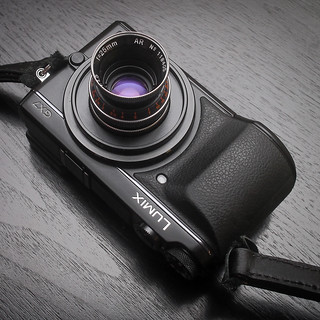
|
| Kern Switar 25mm 1.5 lens adapted onto Panasonic Lumix GX7's µ4/3 bayonet image by Matt Phillips (Image rights) |

|
| C-mount origin 16mm cinematography: Revere Model 38 16mm cine camera with 3 turret mounted C-mount lenses together with related slimmer viewfinder lenses image by Rick Soloway (Image rights) |
The C-mount consists of a one-inch diameter cylinder threaded to a pitch of 1/32-in, or 32 threads per inch. It was designed specifically for lenses used on 16mm cine cameras. However, a small number of subminiature still cameras have been made using the same lenses, including the Schatz Sola, Optikotechna Mikronette and the Doryu pistol-shaped police cameras.
The "C" designation derives from the evolution of the mount from its "A" and "B" predecessors. All shared the same thread and diameter, but had different mounting depths; the three are not interchangeable. A-mount and B-mount lenses were used primarily on Filmo cameras of Bell & Howell. The cine camera and lens maker began to feature interchangeable lenses earlier than its concurrents like Victor. The first C-mount camera was the Bell&Howell's Filmo 70 for 16mm film.
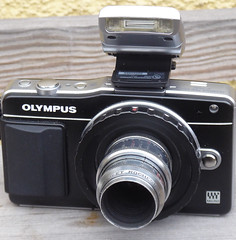
|
| Elgeet 1" f:1.9 25mm adapted on µ4/3 mount of digital Olympus Pen image by Uwe Kulick (Image rights) |
Thread depths varied from maker to maker, but the proper A-B-C distinction lies not in the total thread depth but in the distance from the flange seat of the lens barrel to the innermost thread. The C-mount eventually became the standard mount for higher-quality amateur 16mm cine cameras.
Some of the better quality cameras had a turret with a capacity for two or more lenses for making rapid changes in focal length. Though zoom lenses were available in the 1940's, they were very expensive and involved some optical compromises, so were not widely used until they had achieved better and more consistent quality at lower prices. After this was achieved, they eventually came to replace the turret in the 1960's, particularly in cameras for the amateur film maker. The C-mount zoom lenses became dominating when some professional and amateur video cameras with C-mount appeared.
When video camera design evolved to modern camcorder design the interchangeable lenses vanished, but a few C-mount lenses are still produced for the market of surveillance cameras and industrial process control cameras.
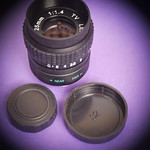
|
| 25mm 1:1.4 TV Lens image by Uwe Kulick (Image rights) |
Cine cameras were often equipped with superb C-mount optics made by renowned lens makers like Kern, Taylor-Hobson, Dallmeyer, Meyer, Angénieux, Elgeet, Berthiot, and Schneider. Wollensak and Kodak also made some fine cine lenses. Video camera C-mount lenses were made for example by Canon and Fuji. Survey lens makers and industry lens makers are Fujian, Rainbow, Computar, Tamron and Pentax (Cosmicar brand).
Contents
C-mount revival
In this century, people have begun to experiment with C-mount lenses on digital (still) cameras, a trend boosted by the launch of the Micro Four Thirds (µ4/3) cameras which have an appropriate flange/sensor distance to allow adaption of the 16mm cine lenses.
Similar new CSC lens mounts which followed like the Sony NEX, Nikon CX, Pentax Q or EOS M mounts allow C-mount lens adaption too. Lens adaptors are widely available except for Samsung's mount.
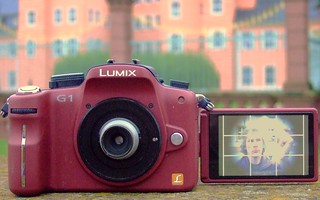
|
| Wollensak Velostigmat adapted to G1, the first µ4/3 CSC image by Uwe Kulick (Image rights) |
Some think the older uncoated lenses may be more satisfactory for bokeh experiments, but a cheap "TV lens" for survey cameras may surprise positively too. Zoom lenses made for C-mount are a bit bulky and heavy but may be attractive for videographers who use for example a Panasonic Lumix GH µ4/3 camera since many C-mount zoomers are much faster than the original CSC zoom lenses.
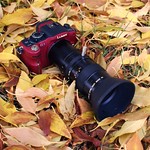
|
| f2 video 6× zoom lens on G1 image by Uwe Kulick (Image rights) |
An issue may be the lens' back when it is longer than its C-mount thread. For example Sony TV-lenses or Rainbow industrial process control lenses might not fit in µ4/3 cameras. Another issue are survey camera lenses for the similar CS-mount which are made for a shorter flange/sensor distance and smaller image size. On C-mount they can make only macro images which must be cropped.
Meanwhile, the image circle of many lenses is unlikely to cover the entire area of the image sensor without serious vignetting since 16mm frame size is smaller than a µ4/3 sensor. Especially wide-angle C-mount lenses covering the whole sensor are very rare. The C-mount enthusiast will have to crop many images and videos shot with C-mount lens.
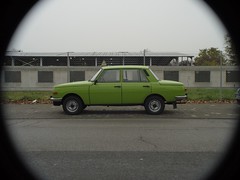
|
| shot w/ f2 video zoom lens shown left image by Uwe Kulick (Image rights) |
Newer options with smaller sensors
The formats APS-C and even µ4/3 are not the ones which were and are in the focus of C-mount lens development. The maximum sensor size of survey cameras is smaller: 1 inch. That's more than 16mm film's 1/2" diagonal, so that several old 16mm movie lenses have a smaller image circle than 1". On the other hand there are survey lenses offered especially for 1" format, and some lenses for 2/3" format with longer focal lengthes may give a 1" image circle too. Thus system cameras with 1" sensors are more convenient concerning sufficient image circle or vignetting of adapted C-mount lenses.
Cheap C-mount adapters are available for the Nikon 1 cameras, but with those gadgets You get your MF lenses only utilisable in M mode of the camera. That means: in manual exposure setting mode. An alternative camera is the Samsung NX mini, but mechanical adapters aren't cheap, only made by one American maker. Of course these adapters enable convenient lens use in A mode, that means aperture priority with automatic exposure time setting, and that means all what C-mount adapters for µ4/3 mount deliver too. But they are not always available. For users of only small C-mount lenses the maker offers a CS mount adapter for the NX mini to which a light C-mount lens easily can be adapted, by means of a 5mm C-mount lens tube extension or a similar C/CS-mount adapter.
But the Nikon 1 system is not out of the game: A chipped adapter can simulate the presence of a system lens so far that automatic shutter speed setting will be usable, too. Of course this adapter isn't cheap, too, since only available from one Russian maker. Thus, both options, either a Nikon 1 camera or the Samsung NX mini, might work conveniently as C-mount-adapting camera, but both for an adapter price that, shipment included, might cost nearly as much as a used camera body.[1]
- ↑ The author recently got a used Nikon 1 V1 for 66€ including shipment, the electronic adapter from Russia would cost at least 61€. My NX mini (used) cost 88€, adapter plus shipment was almost half as much.
adaption gallery

|
| nice bokeh achieved w/ simple TV lens image by Uwe Kulick (Image rights) |

|
| Schneider 1:1.5 25mm Xenon on µ4/3 adapter image by mr. Wood (Image rights) |
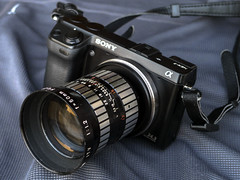
|
| Fujinon ITV 1:1.2 f=50mm covers APS-C image by Paulo Moreira (Image rights) |

|
| Nikon 1 V1 w/ CGL 10 Mega-Pixels 16mm 1:1.4. un-chipped adapter "supported" only in M mode. image by Uwe Kulick (Image rights) |
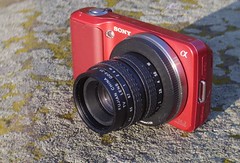
|
| "TV lens" from old Chinese optics factory Fujian: the GDS-35 is sufficient for an APS-C sensor it's a sharp fine weather lens at smallest aperture at wider aperture only image center becomes sharp image by Uwe Kulick (Image rights) |
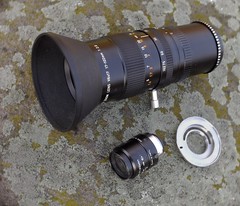
|
| bulky Canon zoomer vs. Rainbow industry lens and special adapter capable to take Kern-Switar lens image by Uwe Kulick (Image rights) |
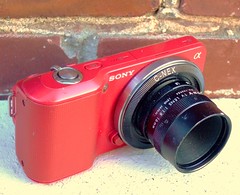
|
| Sony TV LENS 1:1.8 16mm does well with NEX-3's sweep panorama mode which delivers just a cropped image height image by Uwe Kulick (Image rights) |

|
| Schneider Kreuznach Cine Xenon 1:2/50 adapted to Canon EOS M5 image by 情事針寸II (Image rights) |
lenses gallery

|
| right to left: SOM Berthiot Cinor B 1:1.5 F=25 Angénieux 25mm F 1.4 Kern Paillard SWITAR RX 1:1,4 F=25mm Kodak Anastigmat f:1.9 25 mm image by 情事針寸II (Image rights) |
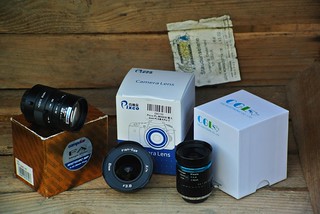
|
| left to right: Computar 12-36mm 1:2.8 2/3" C Pixco Fish-Eye 8mm F3.8 4/3" CGL 10 Mega-Pixels 16mm 1:1.4 image by Uwe Kulick (Image rights) |
Links
- Images made with C-mount lenses on µ4/3 mount on Flickr
- C-mount in Olypedia (German)